Analyzing Cormac's Mental Health: Clinical Handover and Recovery Model
VerifiedAdded on 2019/09/23
|10
|2663
|368
Report
AI Summary
This report provides a detailed analysis of Cormac, a 24-year-old single man diagnosed with schizophrenia. The report begins with a mental status examination, highlighting Cormac's suspiciousness, delusions, flat affect, auditory hallucinations, thought blocking, lack of insight, and orientation. It then applies the 5P model to formulate Cormac's presenting, predisposing, precipitating, and perpetuating factors, and explores his protective factors. Maslow's Hierarchy of Needs is used to assess Cormac's unmet needs and suggest nursing interventions. The clinical handover summarizes Cormac's condition, including his symptoms, medication non-adherence, and unhygienic appearance. The report emphasizes the importance of the therapeutic relationship, cultural safety, and the recovery model in Cormac's treatment, advocating for self-direction, individual-centered care, empowerment, holistic wellness, and strength-based approaches. The report underscores the need for adherence to treatment, addressing hallucinations, and ensuring cultural sensitivity to improve Cormac's quality of life and facilitate his recovery. The document is contributed by a student to be published on the website Desklib.

Cormac
Paraphrase This Document
Need a fresh take? Get an instant paraphrase of this document with our AI Paraphraser
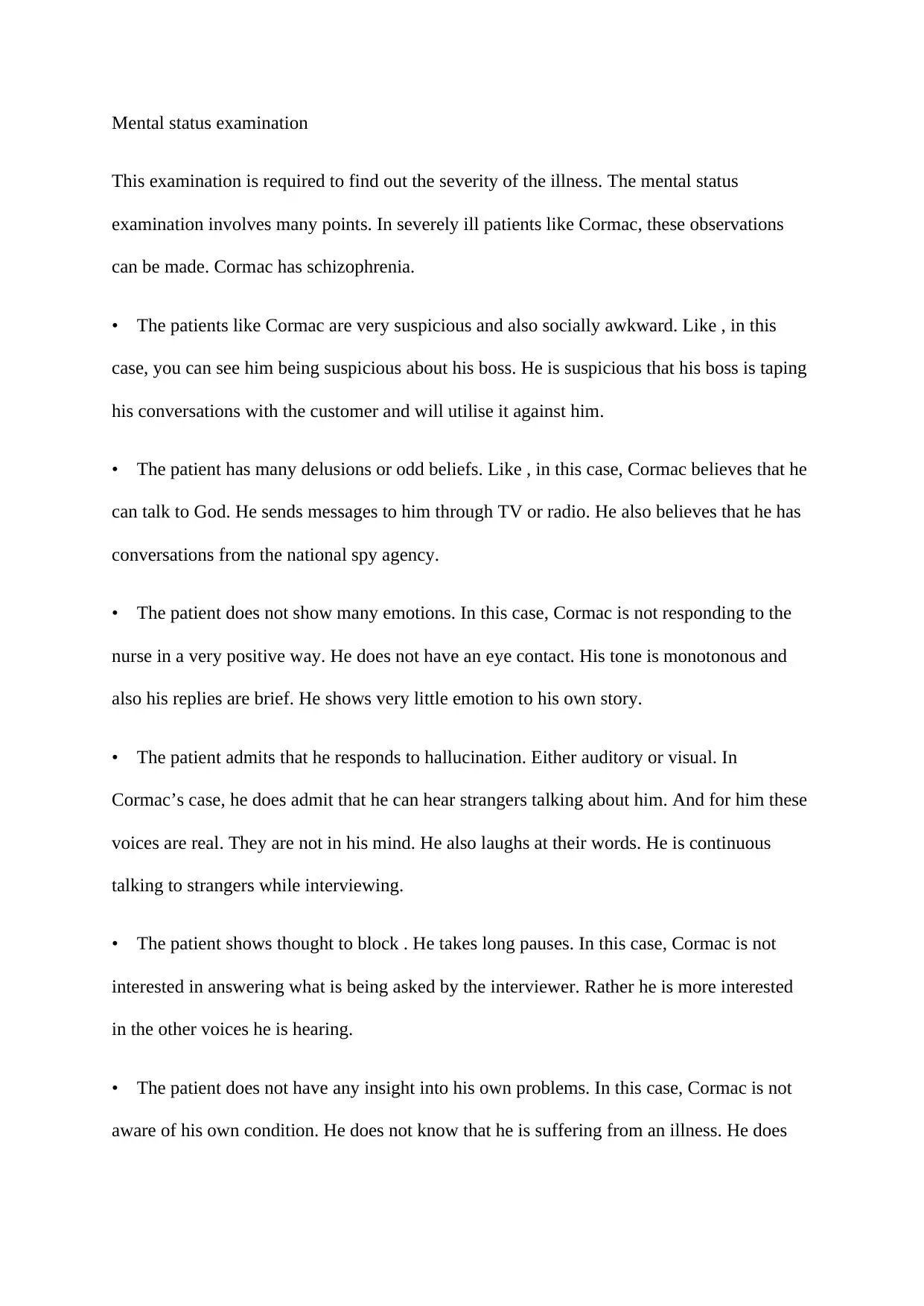
Mental status examination
This examination is required to find out the severity of the illness. The mental status
examination involves many points. In severely ill patients like Cormac, these observations
can be made. Cormac has schizophrenia.
• The patients like Cormac are very suspicious and also socially awkward. Like , in this
case, you can see him being suspicious about his boss. He is suspicious that his boss is taping
his conversations with the customer and will utilise it against him.
• The patient has many delusions or odd beliefs. Like , in this case, Cormac believes that he
can talk to God. He sends messages to him through TV or radio. He also believes that he has
conversations from the national spy agency.
• The patient does not show many emotions. In this case, Cormac is not responding to the
nurse in a very positive way. He does not have an eye contact. His tone is monotonous and
also his replies are brief. He shows very little emotion to his own story.
• The patient admits that he responds to hallucination. Either auditory or visual. In
Cormac’s case, he does admit that he can hear strangers talking about him. And for him these
voices are real. They are not in his mind. He also laughs at their words. He is continuous
talking to strangers while interviewing.
• The patient shows thought to block . He takes long pauses. In this case, Cormac is not
interested in answering what is being asked by the interviewer. Rather he is more interested
in the other voices he is hearing.
• The patient does not have any insight into his own problems. In this case, Cormac is not
aware of his own condition. He does not know that he is suffering from an illness. He does
This examination is required to find out the severity of the illness. The mental status
examination involves many points. In severely ill patients like Cormac, these observations
can be made. Cormac has schizophrenia.
• The patients like Cormac are very suspicious and also socially awkward. Like , in this
case, you can see him being suspicious about his boss. He is suspicious that his boss is taping
his conversations with the customer and will utilise it against him.
• The patient has many delusions or odd beliefs. Like , in this case, Cormac believes that he
can talk to God. He sends messages to him through TV or radio. He also believes that he has
conversations from the national spy agency.
• The patient does not show many emotions. In this case, Cormac is not responding to the
nurse in a very positive way. He does not have an eye contact. His tone is monotonous and
also his replies are brief. He shows very little emotion to his own story.
• The patient admits that he responds to hallucination. Either auditory or visual. In
Cormac’s case, he does admit that he can hear strangers talking about him. And for him these
voices are real. They are not in his mind. He also laughs at their words. He is continuous
talking to strangers while interviewing.
• The patient shows thought to block . He takes long pauses. In this case, Cormac is not
interested in answering what is being asked by the interviewer. Rather he is more interested
in the other voices he is hearing.
• The patient does not have any insight into his own problems. In this case, Cormac is not
aware of his own condition. He does not know that he is suffering from an illness. He does
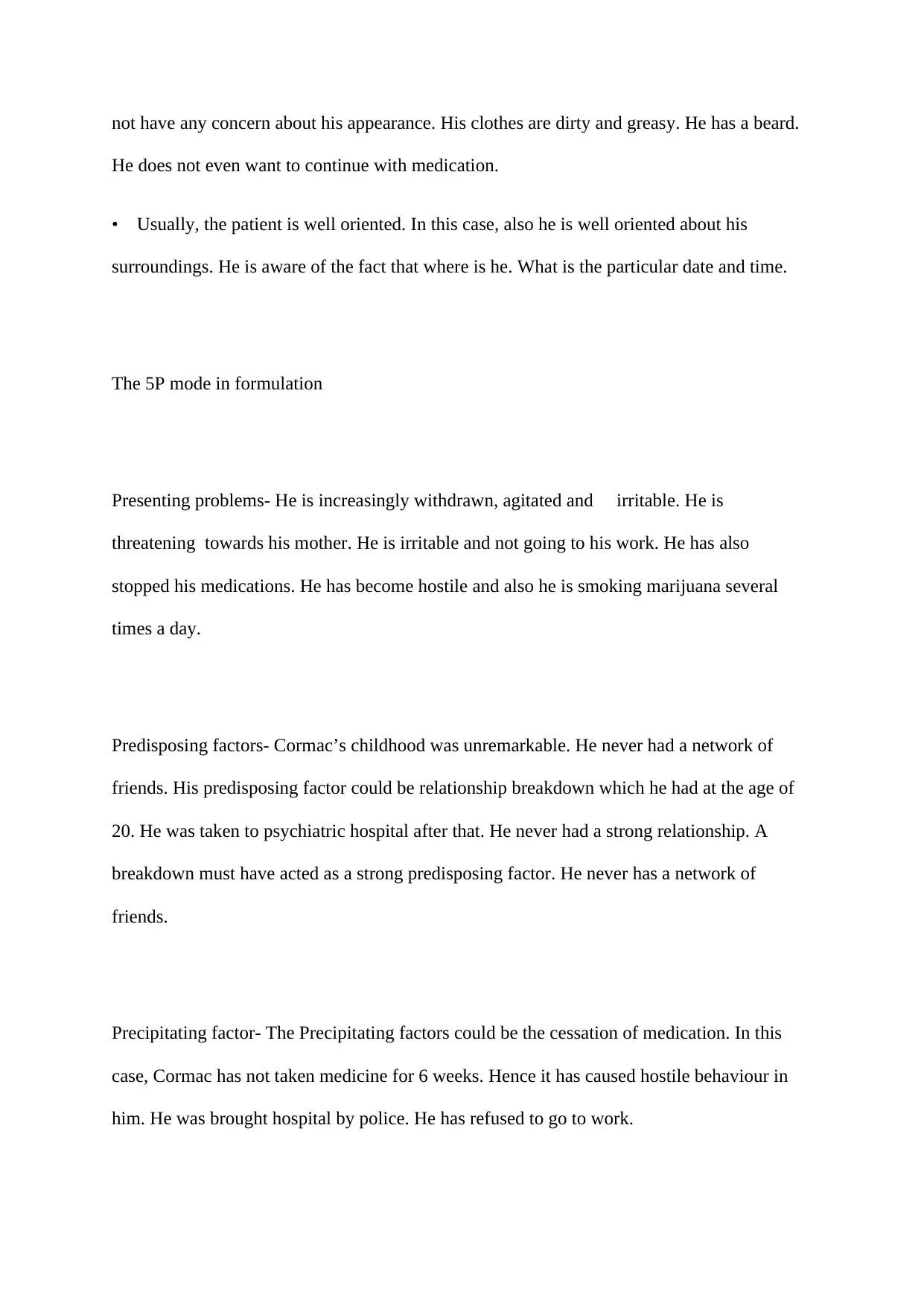
not have any concern about his appearance. His clothes are dirty and greasy. He has a beard.
He does not even want to continue with medication.
• Usually, the patient is well oriented. In this case, also he is well oriented about his
surroundings. He is aware of the fact that where is he. What is the particular date and time.
The 5P mode in formulation
Presenting problems- He is increasingly withdrawn, agitated and irritable. He is
threatening towards his mother. He is irritable and not going to his work. He has also
stopped his medications. He has become hostile and also he is smoking marijuana several
times a day.
Predisposing factors- Cormac’s childhood was unremarkable. He never had a network of
friends. His predisposing factor could be relationship breakdown which he had at the age of
20. He was taken to psychiatric hospital after that. He never had a strong relationship. A
breakdown must have acted as a strong predisposing factor. He never has a network of
friends.
Precipitating factor- The Precipitating factors could be the cessation of medication. In this
case, Cormac has not taken medicine for 6 weeks. Hence it has caused hostile behaviour in
him. He was brought hospital by police. He has refused to go to work.
He does not even want to continue with medication.
• Usually, the patient is well oriented. In this case, also he is well oriented about his
surroundings. He is aware of the fact that where is he. What is the particular date and time.
The 5P mode in formulation
Presenting problems- He is increasingly withdrawn, agitated and irritable. He is
threatening towards his mother. He is irritable and not going to his work. He has also
stopped his medications. He has become hostile and also he is smoking marijuana several
times a day.
Predisposing factors- Cormac’s childhood was unremarkable. He never had a network of
friends. His predisposing factor could be relationship breakdown which he had at the age of
20. He was taken to psychiatric hospital after that. He never had a strong relationship. A
breakdown must have acted as a strong predisposing factor. He never has a network of
friends.
Precipitating factor- The Precipitating factors could be the cessation of medication. In this
case, Cormac has not taken medicine for 6 weeks. Hence it has caused hostile behaviour in
him. He was brought hospital by police. He has refused to go to work.
⊘ This is a preview!⊘
Do you want full access?
Subscribe today to unlock all pages.

Trusted by 1+ million students worldwide

Perpetuating factors-In this case it can be non-cooperation from the parent. As it has been
mentioned that the parents are involved in conflicts. Four years of regular medication has not
caused much relief. Cormac’s condition became worse. There is a possibility that he might
not have received an adequate amount of support from society and parents.
Protective factors- The protective factor is something which stops the individual from
harming himself. For him, it is difficult to see that person in pain. In this case, Cormac is
threatening towards his mother. He cannot be called protective towards him mother. From
the given case he is not found to be protective towards anyone.
Maslow’s Hierarchy of needs
It deals with providing motivation to people. As per him, people have certain motivational
systems. People feels motivated to achieve certain needs. Once a basic level is achieved then
progress towards next level is made.
1) Physiological needs- In this, it has been seen that Cormac is not taking care of himself. He
is having a beard, his hair is long, blond hair is greasy and matted. He is having a washcloth
on his head. Even his clothes are crushed and stained. He is very thin in his appearance. It is
the duty of the nurse to explain to him that he needs to take of himself. He should maintain
his personal hygiene. This will help him to develop a positive attitude towards life.
mentioned that the parents are involved in conflicts. Four years of regular medication has not
caused much relief. Cormac’s condition became worse. There is a possibility that he might
not have received an adequate amount of support from society and parents.
Protective factors- The protective factor is something which stops the individual from
harming himself. For him, it is difficult to see that person in pain. In this case, Cormac is
threatening towards his mother. He cannot be called protective towards him mother. From
the given case he is not found to be protective towards anyone.
Maslow’s Hierarchy of needs
It deals with providing motivation to people. As per him, people have certain motivational
systems. People feels motivated to achieve certain needs. Once a basic level is achieved then
progress towards next level is made.
1) Physiological needs- In this, it has been seen that Cormac is not taking care of himself. He
is having a beard, his hair is long, blond hair is greasy and matted. He is having a washcloth
on his head. Even his clothes are crushed and stained. He is very thin in his appearance. It is
the duty of the nurse to explain to him that he needs to take of himself. He should maintain
his personal hygiene. This will help him to develop a positive attitude towards life.
Paraphrase This Document
Need a fresh take? Get an instant paraphrase of this document with our AI Paraphraser
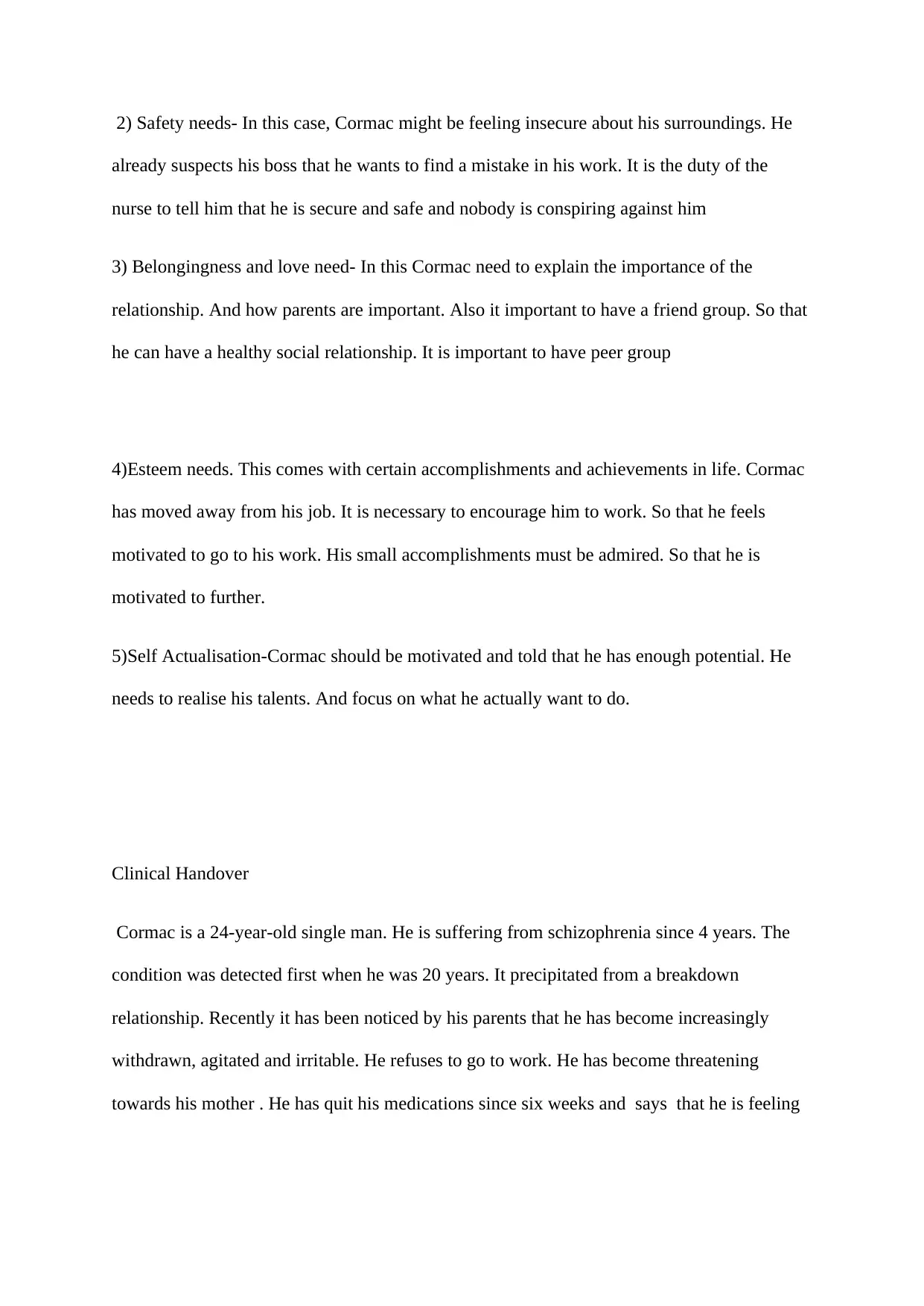
2) Safety needs- In this case, Cormac might be feeling insecure about his surroundings. He
already suspects his boss that he wants to find a mistake in his work. It is the duty of the
nurse to tell him that he is secure and safe and nobody is conspiring against him
3) Belongingness and love need- In this Cormac need to explain the importance of the
relationship. And how parents are important. Also it important to have a friend group. So that
he can have a healthy social relationship. It is important to have peer group
4)Esteem needs. This comes with certain accomplishments and achievements in life. Cormac
has moved away from his job. It is necessary to encourage him to work. So that he feels
motivated to go to his work. His small accomplishments must be admired. So that he is
motivated to further.
5)Self Actualisation-Cormac should be motivated and told that he has enough potential. He
needs to realise his talents. And focus on what he actually want to do.
Clinical Handover
Cormac is a 24-year-old single man. He is suffering from schizophrenia since 4 years. The
condition was detected first when he was 20 years. It precipitated from a breakdown
relationship. Recently it has been noticed by his parents that he has become increasingly
withdrawn, agitated and irritable. He refuses to go to work. He has become threatening
towards his mother . He has quit his medications since six weeks and says that he is feeling
already suspects his boss that he wants to find a mistake in his work. It is the duty of the
nurse to tell him that he is secure and safe and nobody is conspiring against him
3) Belongingness and love need- In this Cormac need to explain the importance of the
relationship. And how parents are important. Also it important to have a friend group. So that
he can have a healthy social relationship. It is important to have peer group
4)Esteem needs. This comes with certain accomplishments and achievements in life. Cormac
has moved away from his job. It is necessary to encourage him to work. So that he feels
motivated to go to his work. His small accomplishments must be admired. So that he is
motivated to further.
5)Self Actualisation-Cormac should be motivated and told that he has enough potential. He
needs to realise his talents. And focus on what he actually want to do.
Clinical Handover
Cormac is a 24-year-old single man. He is suffering from schizophrenia since 4 years. The
condition was detected first when he was 20 years. It precipitated from a breakdown
relationship. Recently it has been noticed by his parents that he has become increasingly
withdrawn, agitated and irritable. He refuses to go to work. He has become threatening
towards his mother . He has quit his medications since six weeks and says that he is feeling
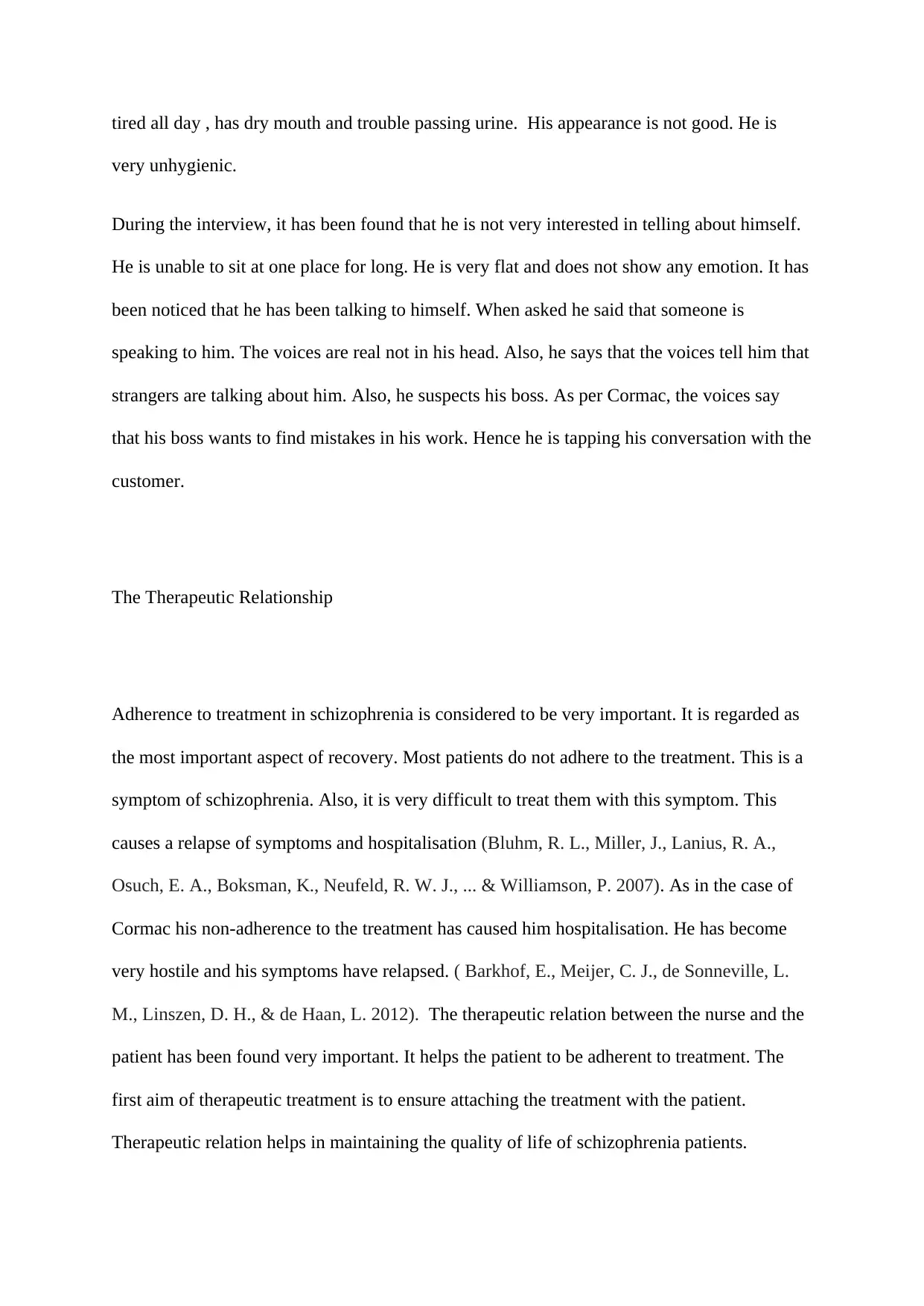
tired all day , has dry mouth and trouble passing urine. His appearance is not good. He is
very unhygienic.
During the interview, it has been found that he is not very interested in telling about himself.
He is unable to sit at one place for long. He is very flat and does not show any emotion. It has
been noticed that he has been talking to himself. When asked he said that someone is
speaking to him. The voices are real not in his head. Also, he says that the voices tell him that
strangers are talking about him. Also, he suspects his boss. As per Cormac, the voices say
that his boss wants to find mistakes in his work. Hence he is tapping his conversation with the
customer.
The Therapeutic Relationship
Adherence to treatment in schizophrenia is considered to be very important. It is regarded as
the most important aspect of recovery. Most patients do not adhere to the treatment. This is a
symptom of schizophrenia. Also, it is very difficult to treat them with this symptom. This
causes a relapse of symptoms and hospitalisation (Bluhm, R. L., Miller, J., Lanius, R. A.,
Osuch, E. A., Boksman, K., Neufeld, R. W. J., ... & Williamson, P. 2007). As in the case of
Cormac his non-adherence to the treatment has caused him hospitalisation. He has become
very hostile and his symptoms have relapsed. ( Barkhof, E., Meijer, C. J., de Sonneville, L.
M., Linszen, D. H., & de Haan, L. 2012). The therapeutic relation between the nurse and the
patient has been found very important. It helps the patient to be adherent to treatment. The
first aim of therapeutic treatment is to ensure attaching the treatment with the patient.
Therapeutic relation helps in maintaining the quality of life of schizophrenia patients.
very unhygienic.
During the interview, it has been found that he is not very interested in telling about himself.
He is unable to sit at one place for long. He is very flat and does not show any emotion. It has
been noticed that he has been talking to himself. When asked he said that someone is
speaking to him. The voices are real not in his head. Also, he says that the voices tell him that
strangers are talking about him. Also, he suspects his boss. As per Cormac, the voices say
that his boss wants to find mistakes in his work. Hence he is tapping his conversation with the
customer.
The Therapeutic Relationship
Adherence to treatment in schizophrenia is considered to be very important. It is regarded as
the most important aspect of recovery. Most patients do not adhere to the treatment. This is a
symptom of schizophrenia. Also, it is very difficult to treat them with this symptom. This
causes a relapse of symptoms and hospitalisation (Bluhm, R. L., Miller, J., Lanius, R. A.,
Osuch, E. A., Boksman, K., Neufeld, R. W. J., ... & Williamson, P. 2007). As in the case of
Cormac his non-adherence to the treatment has caused him hospitalisation. He has become
very hostile and his symptoms have relapsed. ( Barkhof, E., Meijer, C. J., de Sonneville, L.
M., Linszen, D. H., & de Haan, L. 2012). The therapeutic relation between the nurse and the
patient has been found very important. It helps the patient to be adherent to treatment. The
first aim of therapeutic treatment is to ensure attaching the treatment with the patient.
Therapeutic relation helps in maintaining the quality of life of schizophrenia patients.
⊘ This is a preview!⊘
Do you want full access?
Subscribe today to unlock all pages.

Trusted by 1+ million students worldwide
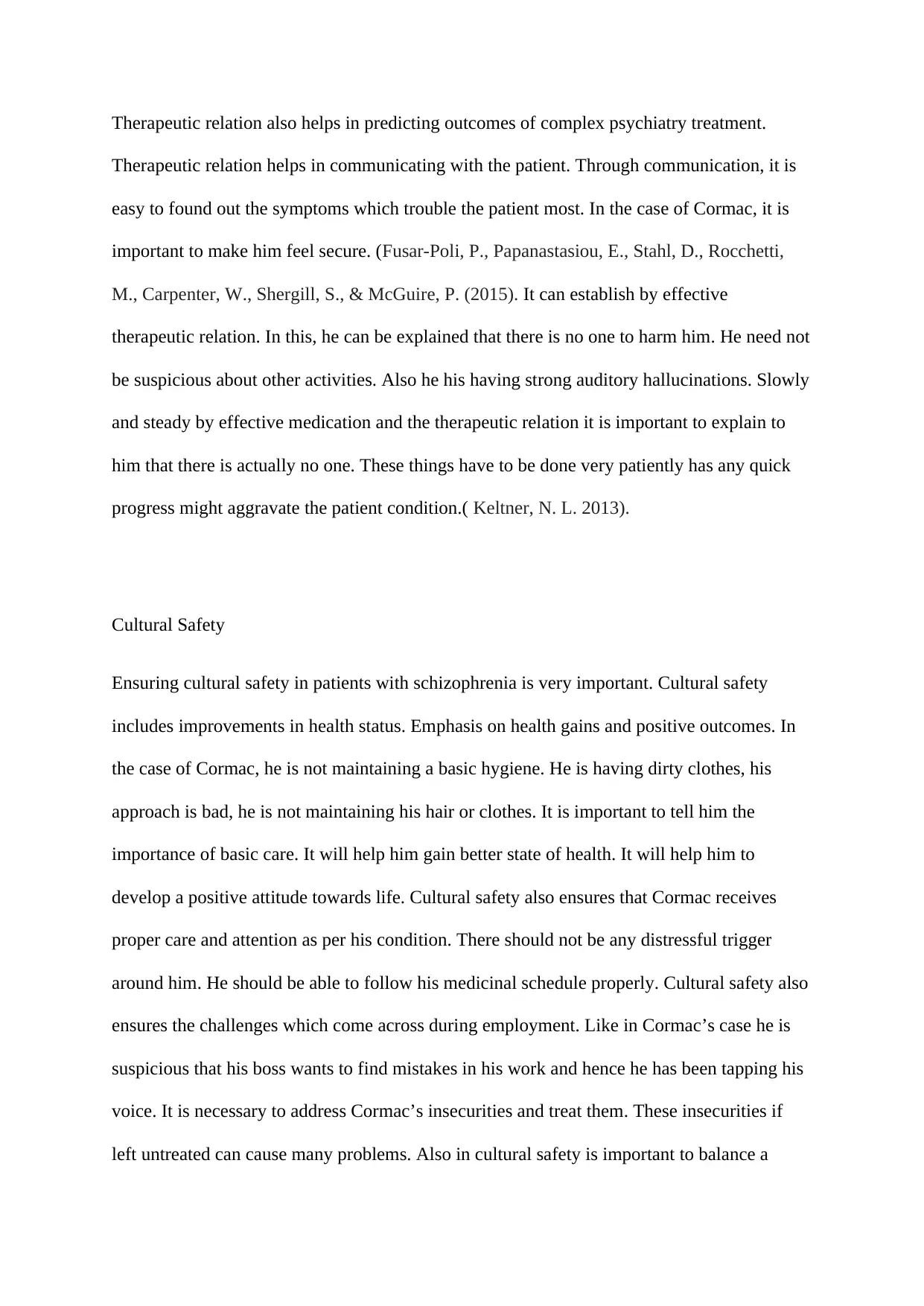
Therapeutic relation also helps in predicting outcomes of complex psychiatry treatment.
Therapeutic relation helps in communicating with the patient. Through communication, it is
easy to found out the symptoms which trouble the patient most. In the case of Cormac, it is
important to make him feel secure. (Fusar-Poli, P., Papanastasiou, E., Stahl, D., Rocchetti,
M., Carpenter, W., Shergill, S., & McGuire, P. (2015). It can establish by effective
therapeutic relation. In this, he can be explained that there is no one to harm him. He need not
be suspicious about other activities. Also he his having strong auditory hallucinations. Slowly
and steady by effective medication and the therapeutic relation it is important to explain to
him that there is actually no one. These things have to be done very patiently has any quick
progress might aggravate the patient condition.( Keltner, N. L. 2013).
Cultural Safety
Ensuring cultural safety in patients with schizophrenia is very important. Cultural safety
includes improvements in health status. Emphasis on health gains and positive outcomes. In
the case of Cormac, he is not maintaining a basic hygiene. He is having dirty clothes, his
approach is bad, he is not maintaining his hair or clothes. It is important to tell him the
importance of basic care. It will help him gain better state of health. It will help him to
develop a positive attitude towards life. Cultural safety also ensures that Cormac receives
proper care and attention as per his condition. There should not be any distressful trigger
around him. He should be able to follow his medicinal schedule properly. Cultural safety also
ensures the challenges which come across during employment. Like in Cormac’s case he is
suspicious that his boss wants to find mistakes in his work and hence he has been tapping his
voice. It is necessary to address Cormac’s insecurities and treat them. These insecurities if
left untreated can cause many problems. Also in cultural safety is important to balance a
Therapeutic relation helps in communicating with the patient. Through communication, it is
easy to found out the symptoms which trouble the patient most. In the case of Cormac, it is
important to make him feel secure. (Fusar-Poli, P., Papanastasiou, E., Stahl, D., Rocchetti,
M., Carpenter, W., Shergill, S., & McGuire, P. (2015). It can establish by effective
therapeutic relation. In this, he can be explained that there is no one to harm him. He need not
be suspicious about other activities. Also he his having strong auditory hallucinations. Slowly
and steady by effective medication and the therapeutic relation it is important to explain to
him that there is actually no one. These things have to be done very patiently has any quick
progress might aggravate the patient condition.( Keltner, N. L. 2013).
Cultural Safety
Ensuring cultural safety in patients with schizophrenia is very important. Cultural safety
includes improvements in health status. Emphasis on health gains and positive outcomes. In
the case of Cormac, he is not maintaining a basic hygiene. He is having dirty clothes, his
approach is bad, he is not maintaining his hair or clothes. It is important to tell him the
importance of basic care. It will help him gain better state of health. It will help him to
develop a positive attitude towards life. Cultural safety also ensures that Cormac receives
proper care and attention as per his condition. There should not be any distressful trigger
around him. He should be able to follow his medicinal schedule properly. Cultural safety also
ensures the challenges which come across during employment. Like in Cormac’s case he is
suspicious that his boss wants to find mistakes in his work and hence he has been tapping his
voice. It is necessary to address Cormac’s insecurities and treat them. These insecurities if
left untreated can cause many problems. Also in cultural safety is important to balance a
Paraphrase This Document
Need a fresh take? Get an instant paraphrase of this document with our AI Paraphraser
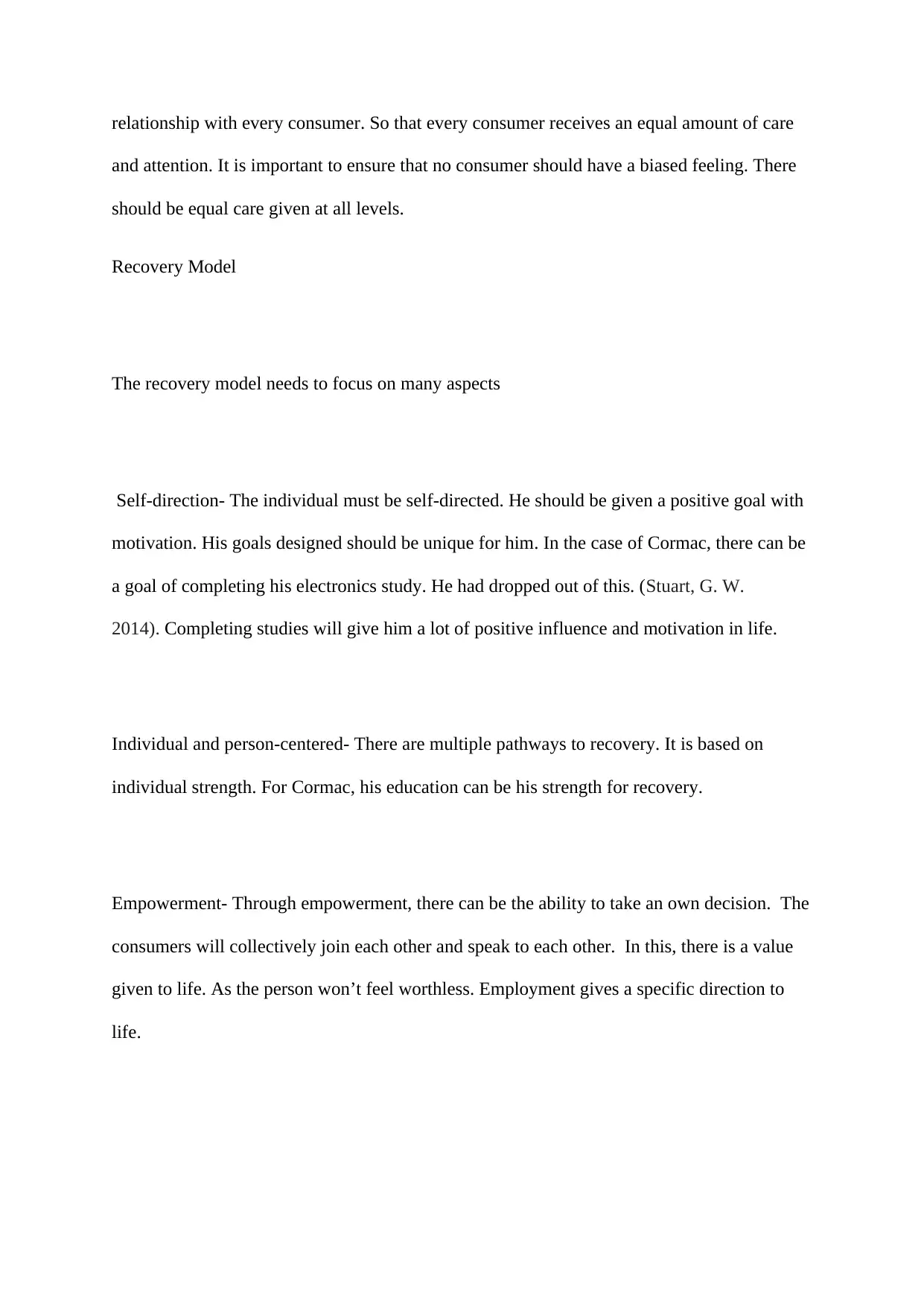
relationship with every consumer. So that every consumer receives an equal amount of care
and attention. It is important to ensure that no consumer should have a biased feeling. There
should be equal care given at all levels.
Recovery Model
The recovery model needs to focus on many aspects
Self-direction- The individual must be self-directed. He should be given a positive goal with
motivation. His goals designed should be unique for him. In the case of Cormac, there can be
a goal of completing his electronics study. He had dropped out of this. (Stuart, G. W.
2014). Completing studies will give him a lot of positive influence and motivation in life.
Individual and person-centered- There are multiple pathways to recovery. It is based on
individual strength. For Cormac, his education can be his strength for recovery.
Empowerment- Through empowerment, there can be the ability to take an own decision. The
consumers will collectively join each other and speak to each other. In this, there is a value
given to life. As the person won’t feel worthless. Employment gives a specific direction to
life.
and attention. It is important to ensure that no consumer should have a biased feeling. There
should be equal care given at all levels.
Recovery Model
The recovery model needs to focus on many aspects
Self-direction- The individual must be self-directed. He should be given a positive goal with
motivation. His goals designed should be unique for him. In the case of Cormac, there can be
a goal of completing his electronics study. He had dropped out of this. (Stuart, G. W.
2014). Completing studies will give him a lot of positive influence and motivation in life.
Individual and person-centered- There are multiple pathways to recovery. It is based on
individual strength. For Cormac, his education can be his strength for recovery.
Empowerment- Through empowerment, there can be the ability to take an own decision. The
consumers will collectively join each other and speak to each other. In this, there is a value
given to life. As the person won’t feel worthless. Employment gives a specific direction to
life.
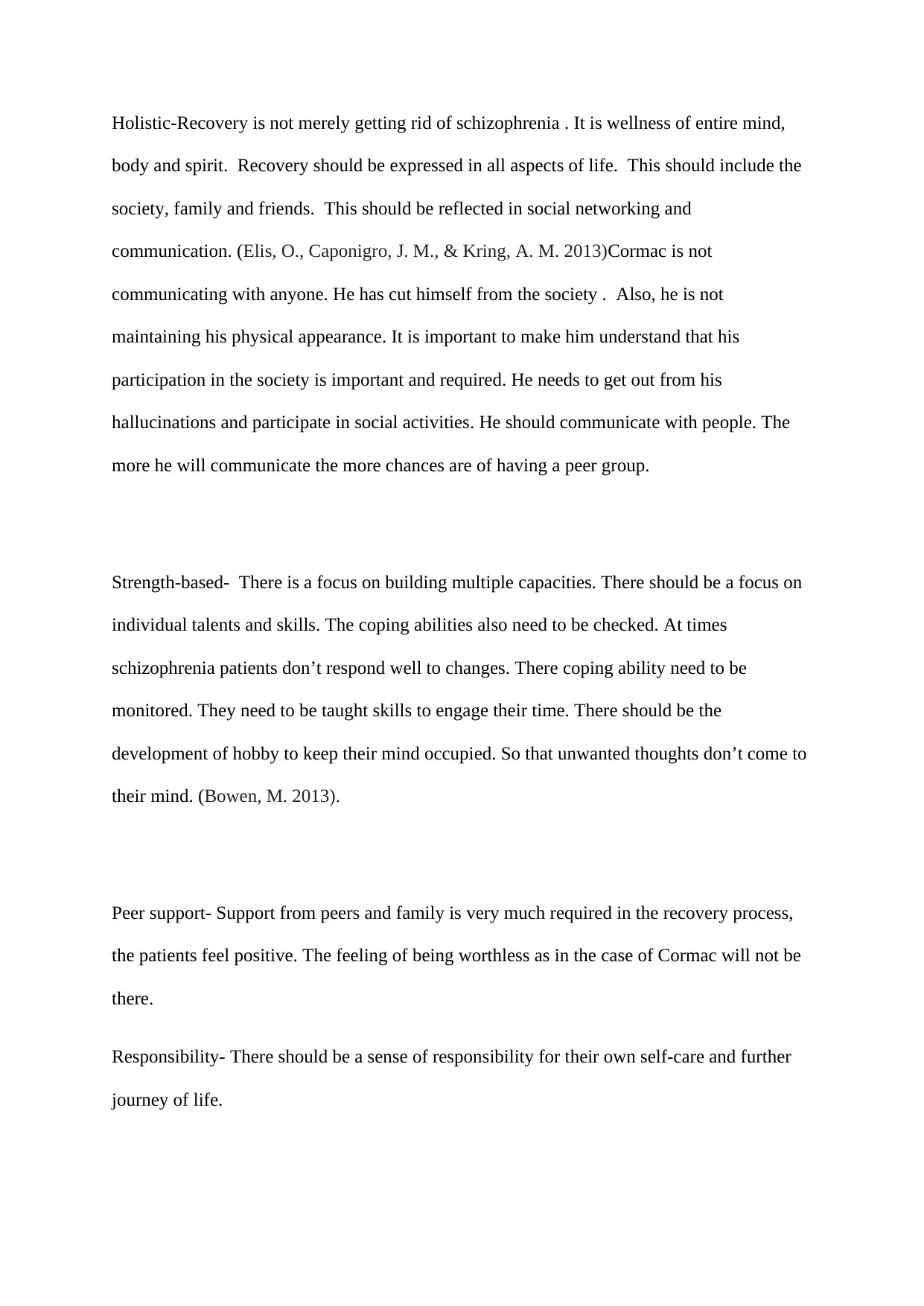
Holistic-Recovery is not merely getting rid of schizophrenia . It is wellness of entire mind,
body and spirit. Recovery should be expressed in all aspects of life. This should include the
society, family and friends. This should be reflected in social networking and
communication. (Elis, O., Caponigro, J. M., & Kring, A. M. 2013)Cormac is not
communicating with anyone. He has cut himself from the society . Also, he is not
maintaining his physical appearance. It is important to make him understand that his
participation in the society is important and required. He needs to get out from his
hallucinations and participate in social activities. He should communicate with people. The
more he will communicate the more chances are of having a peer group.
Strength-based- There is a focus on building multiple capacities. There should be a focus on
individual talents and skills. The coping abilities also need to be checked. At times
schizophrenia patients don’t respond well to changes. There coping ability need to be
monitored. They need to be taught skills to engage their time. There should be the
development of hobby to keep their mind occupied. So that unwanted thoughts don’t come to
their mind. (Bowen, M. 2013).
Peer support- Support from peers and family is very much required in the recovery process,
the patients feel positive. The feeling of being worthless as in the case of Cormac will not be
there.
Responsibility- There should be a sense of responsibility for their own self-care and further
journey of life.
body and spirit. Recovery should be expressed in all aspects of life. This should include the
society, family and friends. This should be reflected in social networking and
communication. (Elis, O., Caponigro, J. M., & Kring, A. M. 2013)Cormac is not
communicating with anyone. He has cut himself from the society . Also, he is not
maintaining his physical appearance. It is important to make him understand that his
participation in the society is important and required. He needs to get out from his
hallucinations and participate in social activities. He should communicate with people. The
more he will communicate the more chances are of having a peer group.
Strength-based- There is a focus on building multiple capacities. There should be a focus on
individual talents and skills. The coping abilities also need to be checked. At times
schizophrenia patients don’t respond well to changes. There coping ability need to be
monitored. They need to be taught skills to engage their time. There should be the
development of hobby to keep their mind occupied. So that unwanted thoughts don’t come to
their mind. (Bowen, M. 2013).
Peer support- Support from peers and family is very much required in the recovery process,
the patients feel positive. The feeling of being worthless as in the case of Cormac will not be
there.
Responsibility- There should be a sense of responsibility for their own self-care and further
journey of life.
⊘ This is a preview!⊘
Do you want full access?
Subscribe today to unlock all pages.

Trusted by 1+ million students worldwide
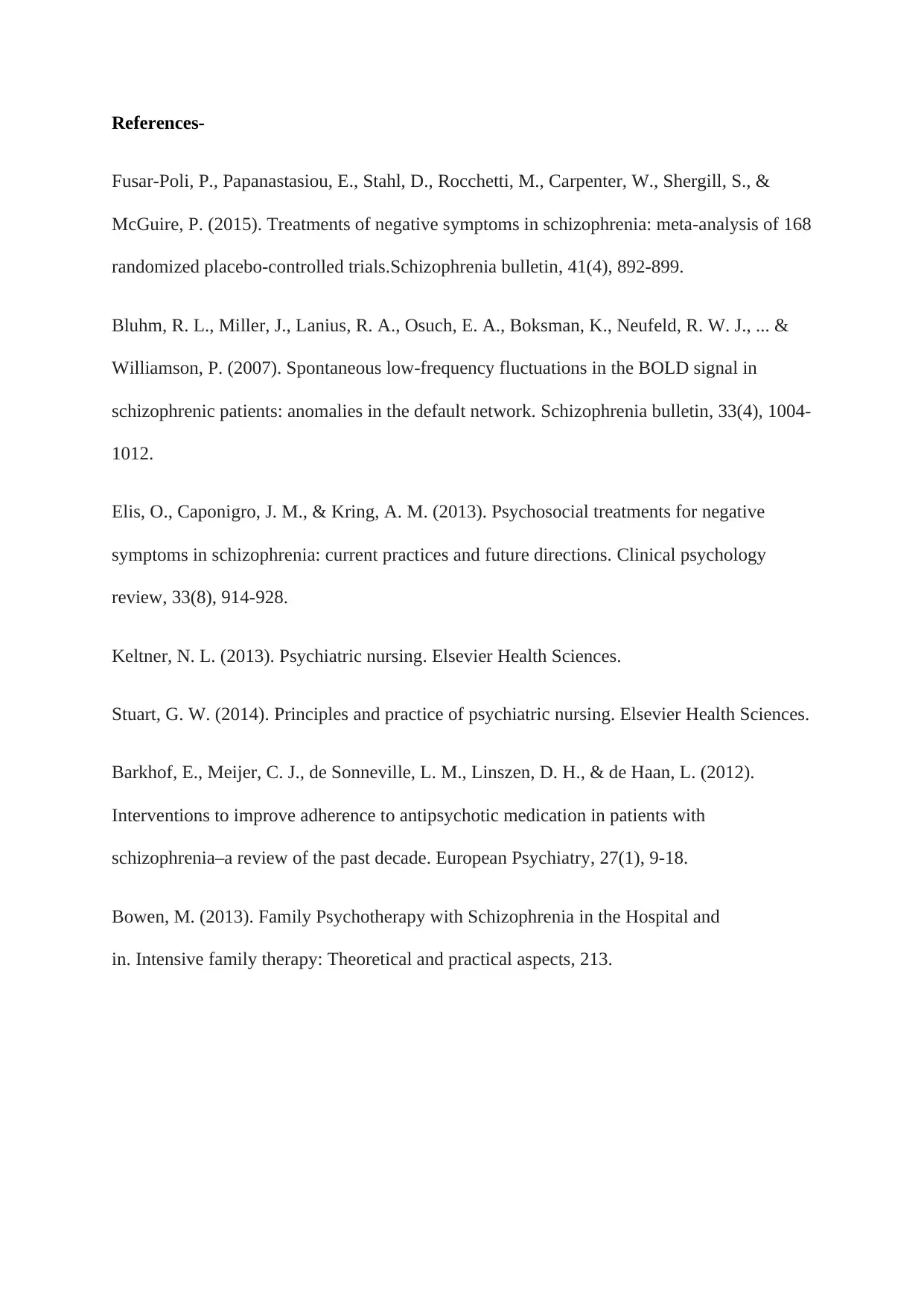
References-
Fusar-Poli, P., Papanastasiou, E., Stahl, D., Rocchetti, M., Carpenter, W., Shergill, S., &
McGuire, P. (2015). Treatments of negative symptoms in schizophrenia: meta-analysis of 168
randomized placebo-controlled trials.Schizophrenia bulletin, 41(4), 892-899.
Bluhm, R. L., Miller, J., Lanius, R. A., Osuch, E. A., Boksman, K., Neufeld, R. W. J., ... &
Williamson, P. (2007). Spontaneous low-frequency fluctuations in the BOLD signal in
schizophrenic patients: anomalies in the default network. Schizophrenia bulletin, 33(4), 1004-
1012.
Elis, O., Caponigro, J. M., & Kring, A. M. (2013). Psychosocial treatments for negative
symptoms in schizophrenia: current practices and future directions. Clinical psychology
review, 33(8), 914-928.
Keltner, N. L. (2013). Psychiatric nursing. Elsevier Health Sciences.
Stuart, G. W. (2014). Principles and practice of psychiatric nursing. Elsevier Health Sciences.
Barkhof, E., Meijer, C. J., de Sonneville, L. M., Linszen, D. H., & de Haan, L. (2012).
Interventions to improve adherence to antipsychotic medication in patients with
schizophrenia–a review of the past decade. European Psychiatry, 27(1), 9-18.
Bowen, M. (2013). Family Psychotherapy with Schizophrenia in the Hospital and
in. Intensive family therapy: Theoretical and practical aspects, 213.
Fusar-Poli, P., Papanastasiou, E., Stahl, D., Rocchetti, M., Carpenter, W., Shergill, S., &
McGuire, P. (2015). Treatments of negative symptoms in schizophrenia: meta-analysis of 168
randomized placebo-controlled trials.Schizophrenia bulletin, 41(4), 892-899.
Bluhm, R. L., Miller, J., Lanius, R. A., Osuch, E. A., Boksman, K., Neufeld, R. W. J., ... &
Williamson, P. (2007). Spontaneous low-frequency fluctuations in the BOLD signal in
schizophrenic patients: anomalies in the default network. Schizophrenia bulletin, 33(4), 1004-
1012.
Elis, O., Caponigro, J. M., & Kring, A. M. (2013). Psychosocial treatments for negative
symptoms in schizophrenia: current practices and future directions. Clinical psychology
review, 33(8), 914-928.
Keltner, N. L. (2013). Psychiatric nursing. Elsevier Health Sciences.
Stuart, G. W. (2014). Principles and practice of psychiatric nursing. Elsevier Health Sciences.
Barkhof, E., Meijer, C. J., de Sonneville, L. M., Linszen, D. H., & de Haan, L. (2012).
Interventions to improve adherence to antipsychotic medication in patients with
schizophrenia–a review of the past decade. European Psychiatry, 27(1), 9-18.
Bowen, M. (2013). Family Psychotherapy with Schizophrenia in the Hospital and
in. Intensive family therapy: Theoretical and practical aspects, 213.
1 out of 10
Related Documents
Your All-in-One AI-Powered Toolkit for Academic Success.
+13062052269
info@desklib.com
Available 24*7 on WhatsApp / Email
![[object Object]](/_next/static/media/star-bottom.7253800d.svg)
Unlock your academic potential
Copyright © 2020–2025 A2Z Services. All Rights Reserved. Developed and managed by ZUCOL.





